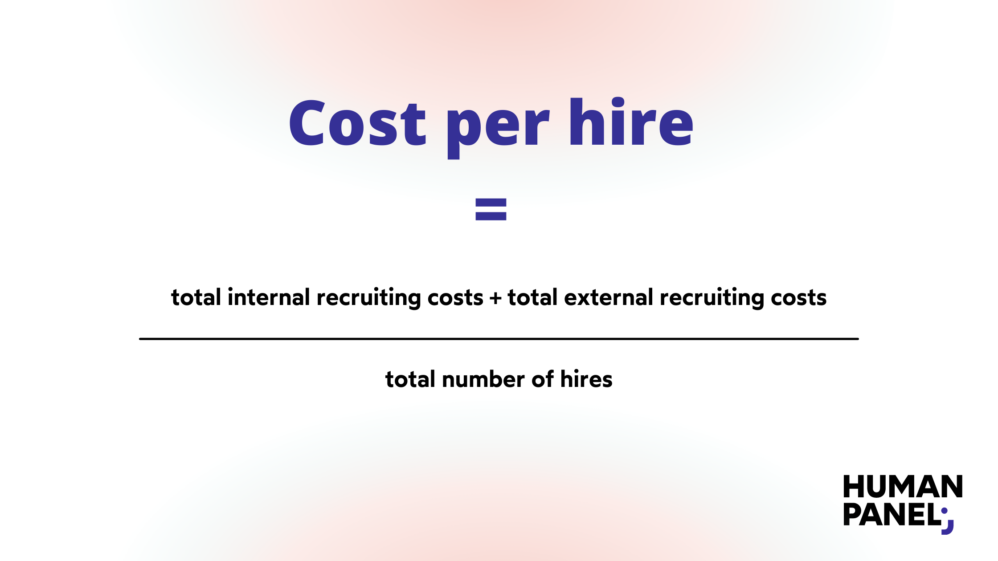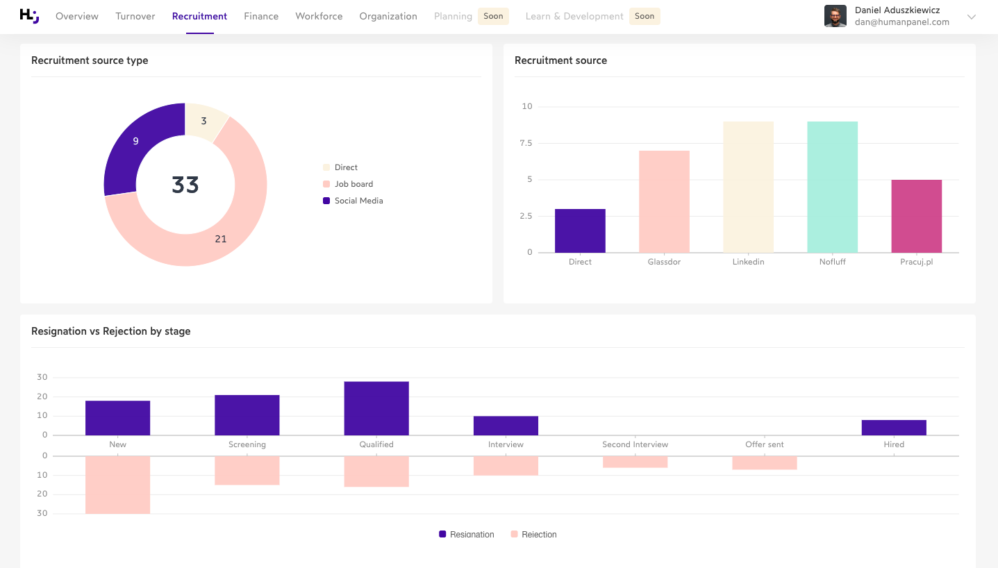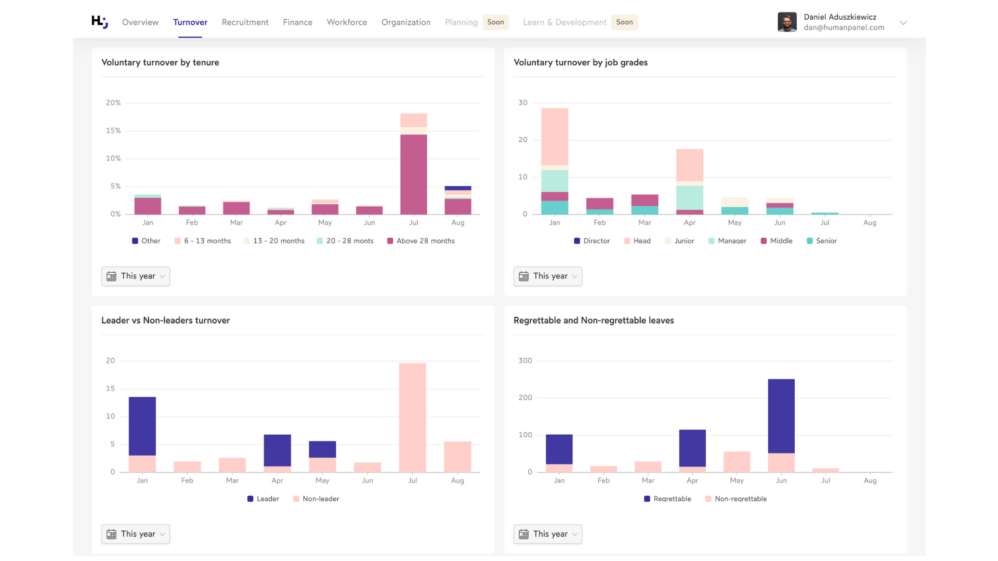HR metrics that matter most for successful recruitment and retention

We break down the key HR metrics that matter and that every company needs to track for an effective recruiting and retention strategies.
“Without data we are blind”. This phrase is quoted by many HR executives because making informed HR decisions is a must today. If you want your hiring strategy to be effective and data-driven, you need to track the right numbers and look at the data holistically. Here is what HR metrics are for.
Table of contents
Chapter I: 11 HR metrics that matter in recruitment
DOWNLOAD THIS CHAPTER AS A PDF
Chapter II: HR metrics that matter in retention
What are HR metrics?
HR metrics are measurements used to determine the effectiveness of HR processes. They are used to determine the effectiveness and ROI of all investments and initiatives you make in HR. This way, your HR can become data-driven just like sales or marketing. When you operate on HR metrics and set measurable goals, you get rid of guessing and gut feeling from your HR management.
Today, with the right people analytics tool, HR metrics provide your with much more than simple reporting. Thanks to them you can analyze the trends to answer questions critical to your business, such as:
Hiring
- How many employees I need to hire to support the business growth?
- How long it takes a new hire to become productive?
- How much it costs me to recruit a new hire?
- How effective your recruitment funnel is?
- Why do candidates reject my offfers?
Turnover
- How many employees leave the company?
- Why do they leave?
- What teams they belong to?
- Who’s their leader?
- How much do they earn?
- When was the last time they got promoted?
- How much the turnover costs my company?
Read also: How to build a people analytics strategy in your company?
Which HR metrics matter the most?
Most HR leaders agree that the HR metrics that matter most today are those related to hiring process and retention. Of course, a lot depends on the problem you have and you want to solve but those two areas: recruitment and retention, are key to any HR strategy today.
This is where people analytics platform can help. Such a platform collects all your HR data in one place and helps you manage all HR processes that are important to you. The data is visualized and standardized so that anyone can access it – not just HR analysts. We also take care of the data cleansing, all integrations and automation, so there is no painful starting point.

11 HR metrics that matter in recruitment
DOWNLOAD THIS CHAPTER AS A PDF
List of the key recruitment HR metrics you get with Human Panel:

Time to hire

Time to fill

Time to onboard

Cost of hire

Source of hire

Open positions

Application completion rate

Applications per opening

Candidates per hire

Offers acceptance rate

Recruitment funnel efficiency
1. Time to hire
Definition
The number of days between the time you contact a candidate and the time a candidate accepts your offer.
In other words, it counts the days from the time a candidate enters your recruiting pipeline. It answers the question: how many days does it take to hire someone after a candidate applies for the job or after you reach out to a candidate? It shows how quickly you can select the right candidate once you have multiple candidates in your pipeline. It can also show you how efficient your recruitment process is.
How do you calculate time to hire?
Measure the number of days from the day a candidate applies for the job or you approach the candidate to the day the offer is accepted.

Why is time to hire important?
Today, time is critical in talent acquisition because the competition is very fierce. Thus, you need to keep a candidate very engaged throughout the recruitment process. If you drag the process out too much, you can easily lose people.
Also, cutting down time to hire means significant savings. Every day of keeping a vacant position costs, and therefore many companies try to keep their time to hire under 30 days.
2. Time to fill
Definition
The number of days between the time you post (or receive approval for) a job posting and the time a candidate accepts your offer.
In other words, it counts the days from the moment you create a job posting to the day you hire a candidate. It answers the question: How many days does the whole recruitment process take?
How do you calculate the time to fill?
Measure the number of days from the day a job offer is posted (or you agree the job posting with your supervisor) to the day the offer is accepted by candidate.

Why is time to fill important?
This metric is mainly used for business planning and shows what the supply/demand ratio is for certain jobs. It also shows how long your overall hiring process takes.
Read more about time to hire and time to fill HR metrics.

3. Time to onboard
Definition
The number of days between the candidate’s acceptance of your offer and the time a new employee begins to make a meaningful contribution.
Read more about average onboarding time and other onboarding statistics.
How do you calculate time to onboard?

Why is time to onboard important?
In today’s market, attracting and retaining talent has never been more difficult. The onboarding process can make the difference between a new employee’s success or failure. A study by Gallup shows that companies with a good onboarding process increase new employee retention by 82% and productivity by over 70%. Effective onboarding also reduces mistakes and increases employee retention.
On the other hand, new employees are twice as likely to look for other opportunities after a negative onboarding experience. For this reason, you should have a well-designed onboarding process.
With Human Panel, you can easily track those three metrics – time to hire, time to fill, and time to onboard with a comprehensive dashboard:

4. Cost per hire
Definition
Cost per hire is the average amount of money you spend to hire an employee. In other words, it is used to measure how much it costs you to fill a job opening.
How do you calculate the cost per hire?
To calculate the cost per hire, you should add up all your expenses – both internal and external. Then divide that total by the number of hires in a given period.
The expenses involved in the total hiring costs can include:
- Salaries of internal recruiters
- Salaries of external recruiters
- Fees for job boards
- Fees for recruitment software
- Relocation costs
- Costs of a referral program
- Costs of a background check.

According to SHRM, the average employee hire cost in the United States is $4,129 per job. If your cost per hire is above the market average, there are several ways to lower it. One of them is shortening your time to hire and time to fill, and therefore, increasing the efficiency of your recruitment team.
People analytics platform can also be useful in lowering the cost of hire. It’s easier to add all recruitment expenses and see where you can make any saving.
5. Source of hire
Definition
Hiring source indicates the percentage of your new hires that came from a particular source or channel – e.g., job boards, referrals, direct approach, internal promotion, etc.
What are source of hire examples?
The examples of source of hire include:
- Job boards
- Employee referral programs
- Social media
- Company careers page
- External agencies
- Job fairs
Why is source of hire important?
Knowing your best hiring sources will help you allocate your budget more effectively. For example, if you hired 10 people last month and half of them came through referrals, two through job boards, three through direct hire and none through the outside agency, you know which channel is efficient and which is not. This way you can direct more resources to the most valuable channels and drop those that do not bring candidates.
Here’s how source of hire chart pie looks in the Human Panel dashboard.

6. Open positions (vacancy rate)
Definition
The number of job openings in your company. This metric can be expressed as a percentage of job openings compared to the total number of jobs in a particular department or in the company as a whole.
How to calculate the % of open positions?

Human Panel HR software allows you to track more recruiting HR metrics such as job openings by department, team, and seniority, and view the profiles of all candidates. To learn more about the features, click here.

Why is this metric important?
A high percentage can be a sign of a high demand or a low supply in the job market. It can also mean that there are jobs available, but they remain unfilled.
The low rate of vacancies could be an indicator of good HR processes in the company and the attractiveness of the vacancies that are advertised. In other words, it might mean that there is a great demand in the market for the advertised job offers.
Read more about the vacancy rate.
7. Application completion rate
Definition
The ratio of applications submitted to the total number of applications started.
How to calculate the application completion rate?

Why is this metric important?
The application completion rate measures the success of the recruitment system. It may be of particular interest if your company uses a dedicated online recruiting platform that requires candidates to enter their information and CV. If your application completion rate is low, it may mean that candidates are not getting on with the system and are dropping out. The reasons could be a non-user-friendly interface, poorly organized questions, inappropriate questions, technical issues, etc.
8. Applications per opening
Definition
The number of applications per job vacancy.
Why is this metric important?
The number of applicants per job opening gives an indication of the popularity of the job. A very large number of applicants can indicate two things: either a high demand for jobs or a job description that is too broad.
The number of applications per job opening is not an indicator of the number of suitable candidates. This is measured by another metric – candidates per hire, which we explain below.
9. Candidates per hire
Definition
The number of candidates interviewed before one is hired.
Why is this metric important?
Candidates per hire measures the effectiveness of your recruiting methods. Some companies set a goal of 3-5 interviews per open position to save the hiring manager’s time and resources.
With Human Panel, you can filter how many candidates are in your pipeline for a given position by department and stage of the funnel. You also have access to all candidate profiles.

10. Offer acceptance rate
Definition
The percentage of candidates who accepted a formal job offer.
How do you calculate offer acceptance rate?

Why is this metric important?
The offer acceptance rate tells you how attractive your final offer is to a candidate. A low acceptance rate may indicate compensation problems or a poor interview.
The goal of most companies is to have a high acceptance rate of offers. A rate of over 90% shows that there is a good match between the company’s requirements and the expectations of the selected candidates.
Read more how to improve your offer acceptance rate.
With Human Panel, you can also track how many candidates are rejected at each stage of the recruitment process and how many resign on their own.

11. Recruitment funnel efficiency
Recruiting is a process that resembles a sales funnel – it starts with sourcing candidates and ends with signing a contract. Many companies measure the effectiveness of the various steps in the funnel, which allows them to identify roadblocks and money wasters and optimize the entire process.
With people analytics, you can analyze each stage of the funnel and see how efficient your team is.

83% of leaders say they lack the talent they need to achieve strategic KPIs. Don’t be one of them. In times of an extraordinary competition you need to be fast and agile to be the best. Sign up for a free demo of Human Panel and learn what other metrics you can track for efficient recruitment.
Ready to start people analytics with Human Panel?
DOWNLOAD THIS CHAPTER AS A PDF
Key HR metrics in turnover and retention
List of turnover & retention HR metrics you get with Human Panel:

Total turnover

Early turnover

eNPS

Absence rate
Those indicators allow you to track:
1. Total turnover rate
Definition
The number of employees who leave your organization within a given period.
This metric is often shown as turnover rate, defined as the percentage of employees who left a company over a certain period of time. It usually includes voluntary resignations, dismissals, and retirements. It doesn’t include internal movements like promotions or transfers.
With Human Panel, you can track the turnover by leaders, departments, tenure, and job grades. It’s also possible to distinguish between leader vs non-leader turnover and between non-regrettable and regrettable turnover.
Regrettable turnover is when an employee’s departure from a company has a negative impact on the team or organization. Non-regrettable turnover means a departure that did not hurt the company.
2. New hire turnover rate
Definition
The percentage that indicates how many employees leave the company in their first year on the job.
How to calculate new hire turnover?

Why is this metric important?
New hire turnover is nothing out of the ordinary – about 20% of employees leave within the first 45 days of employment. The reasons may be a poor relationship with their supervisor, inadequate training, or disappointment with their job. There are ways to reduce high employee turnover – and people analytics can help you identify the reasons for first-year turnover. Learn more about turnover or sign up for our free demo with us:

3. eNPs (Employee Net Promoter Score)
The number of employees who would recommend your company as a good place to work versus the number of employees who wouldn’t, indicating overall employees satisfaction.
This metric is considered one of the most efficient indicators of employee satisfaction. With Human Panel, you can track th eNPs by department, team, and project.

4. Absence rate
The rate of unplanned absence due to sickness or other causes. The rate can be measured for an individual, team, or the company as a whole.
An absence rate of 1.5% is considered normal. A lower rate may indicate employees are afraid of taking unscheduled absences, preferring presenteeism that could indicate issues with company culture. A higher rate may indicate another range of issues impacting employee wellbeing.
What are other HR metrics that matter?
The above list of key HR metrics is not exhaustive. At Human Panel, we can design a customized solution according to the needs of your organization. Before you make any decision, we schedule free workshops for you and your team to discuss your challenges and prepare a custom solution.
Probably you’re wondering about the costs of implementing people analytics solution. They can positively surprise you – that we know. Sign up for our free demo to learn details and see how people analytics solution works in practice.



